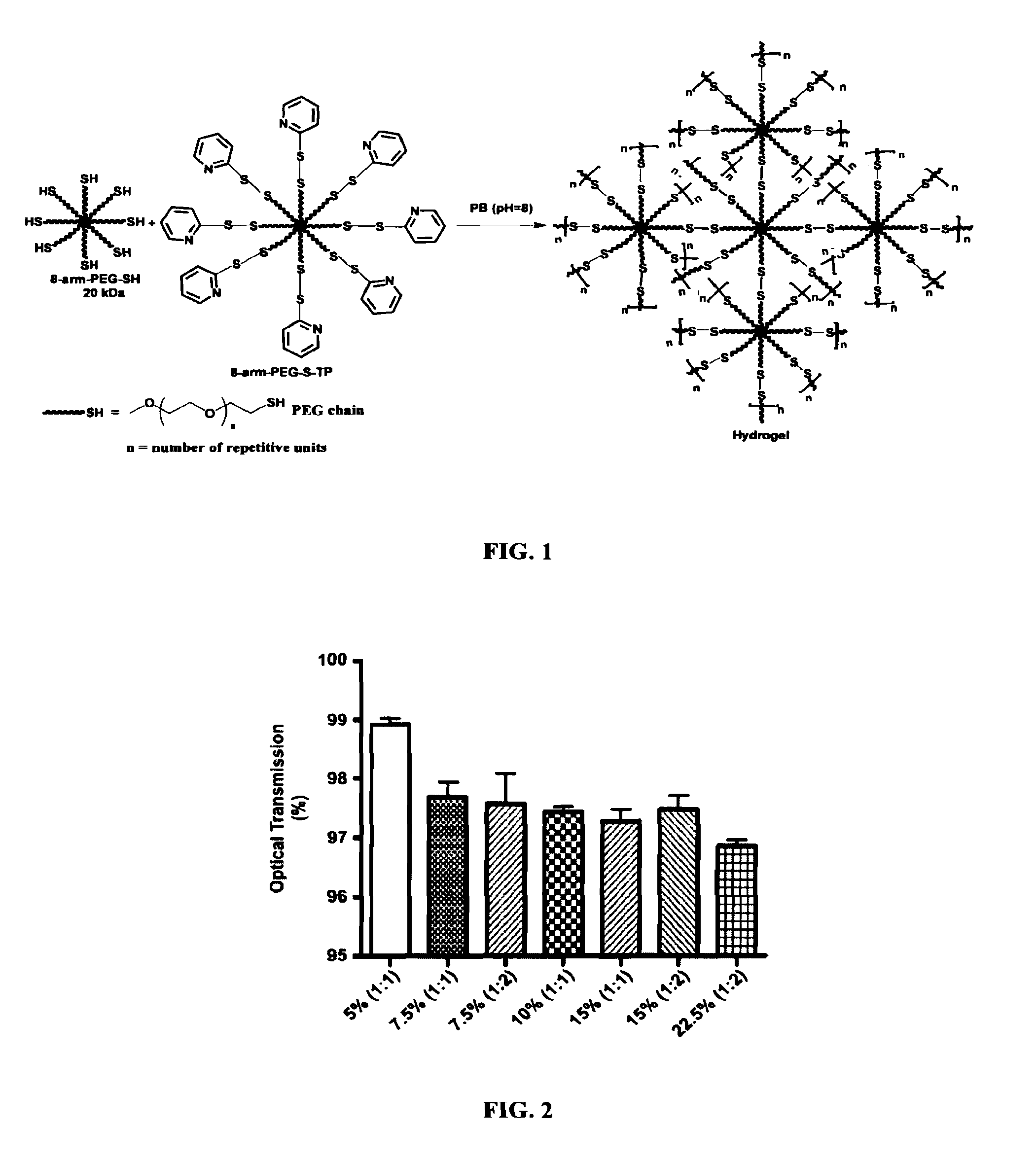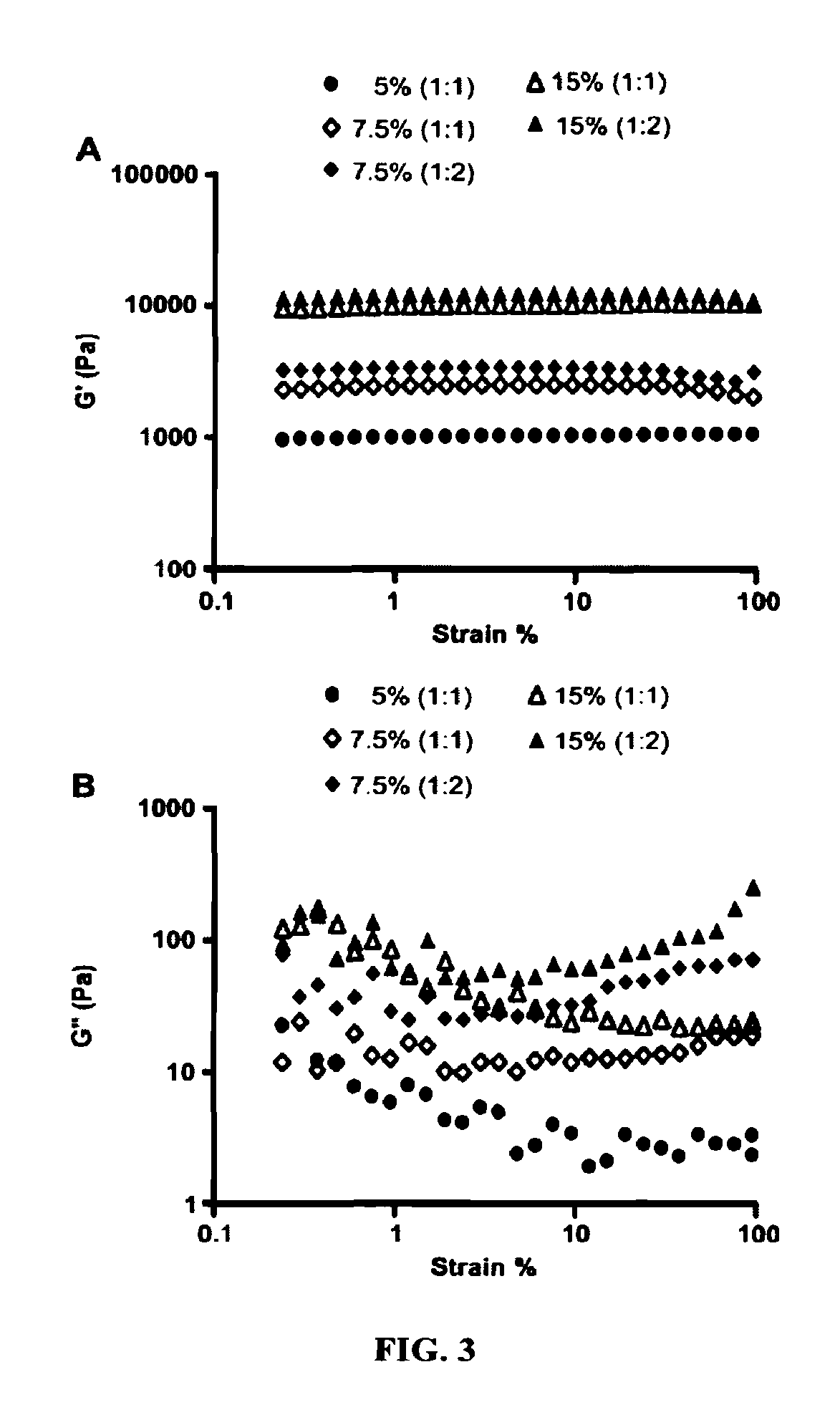Hydrogel formulation for dermal and ocular delivery
a technology of ocular delivery and hydrogel formulation, which is applied in the direction of tetracycline active ingredients, pharmaceutical delivery mechanisms, pharmaceutical non-active ingredients, etc., can solve the problems of eye, skin and respiratory system damage, eye and skin damage, inability to see clearly, and inability to carry,
- Summary
- Abstract
- Description
- Claims
- Application Information
AI Technical Summary
Benefits of technology
Problems solved by technology
Method used
Image
Examples
example 1
Preparation of Doxycycline Hydrogel Using 8 Arm PEG-SH and 8 Arm PEG NHS
[0087]A. Preparation of Sodium Phosphate Buffer (0.1 M, pH 8.00±0.05)
[0088]A solution of sodium phosphate dibasic (1 M, Catalog # S-9763, Sigma Aldrich, St. Louis, Mo.) was prepared in a volumetric flask by dissolving 14.2 grams of salt in 100 mL of deionized (DI) water. Similarly, the solution of sodium phosphate monobasic (1M, Catalog # S-0751, Sigma Aldrich, St. Louis, Mo.) was prepared in another flask by dissolving 12.0 grams of salt in 100 mL DI water. 9.32 mL of sodium phosphate dibasic and 0.68 ml of sodium phosphate monobasic solutions were transferred to a beaker. DI water (80.0 mL) was added to the beaker and the pH of the solution was measured as described in example 3A. The pH was adjusted to 8.00 using 0.1 N sodium hydroxide solution (Catalog # SS276-4, Fisher Scientific, Suwanee, Ga.). The buffer was transferred to a volumetric flask and DI water was added to adjust the final buffer volume to 100 ...
example 2
Preparation of Doxycycline Hydrogels Using 8 Arm PEG-SH (H2O2)
[0096]Phosphate buffer is prepared as in example 1.
[0097]A. Preparation of Polymer Solution
[0098]8-arm PEG20kDa-[SH]8 (4 mg, Catalog # SUNBRIGHT PTE-200SH, NOF America Corporation, White Plains, N.Y.) was weighed in a centrifuge tube and dissolved in PB (100 μL) by vortexing for <1 minutes.
[0099]B. Preparation of Hydrogel (0.2 mL)
[0100]The polymer solution (100 μL) containing the nanocarrier was transferred to a glass vial (12×32 mm, SepCap clear vial, Catalog # C4011-80, National Scientific Company, Rockwood, Tenn.) followed by H2O2 solution (1.9 μL) was added into the polymer solution. The solution mixture was allowed to stand at room temperature (24° C.). The hydrogel solution started becoming more and more viscous after 40 Sec and ceased to flow from the inverted tube in 78 Sec indicating the formation of hydrogel.
[0101]Hydrogel examples with passively entrapped drugs are summarized in Table 3.
TABLE 3Total wt ofTime f...
example 3
Preparation of Minocycline Hydrogel Using 8 Arm PEG-SH and 8 Arm PEG NHS
[0102]Phosphate buffer is prepared as in example 1.
[0103]A. Preparation of Polymer Solution
[0104]8-arm PEG20kDa-[SH]8 (10 mg, Catalog # SUNBRIGHT PTE-200SH, NOF America Corporation, White Plains, N.Y.) was weighed in a centrifuge tube and dissolved in PB (100 μL) by vortexing for <1 minutes.
[0105]B. Preparation of Cross-Linker Solution Containing the Nanocarrier
[0106]8-arm PEG20kDa-[NHS]8 (10 mg, Catalog # SUNBRIGHT PTE-200GS, NOF America Corporation, White Plains, N.Y.) was weighed in a centrifuge tube and dissolved in PB (100 μL). The Minocycline (0.6 mg,) was added to this solution and vortexed (<1 minutes) to make a clear solution.
[0107]C. Preparation of Hydrogel (0.2 mL)
[0108]The cross-linker solution (100 μL) containing the nanocarrier was transferred to a glass vial (12×32 mm, SepCap clear vial, Catalog # C4011-80, National Scientific Company, Rockwood, Tenn.) followed by the polymer solution (100 μL). Th...
PUM
| Property | Measurement | Unit |
|---|---|---|
| molecular weight | aaaaa | aaaaa |
| molecular weight | aaaaa | aaaaa |
| molecular weight | aaaaa | aaaaa |
Abstract
Description
Claims
Application Information
 Login to View More
Login to View More - R&D
- Intellectual Property
- Life Sciences
- Materials
- Tech Scout
- Unparalleled Data Quality
- Higher Quality Content
- 60% Fewer Hallucinations
Browse by: Latest US Patents, China's latest patents, Technical Efficacy Thesaurus, Application Domain, Technology Topic, Popular Technical Reports.
© 2025 PatSnap. All rights reserved.Legal|Privacy policy|Modern Slavery Act Transparency Statement|Sitemap|About US| Contact US: help@patsnap.com



